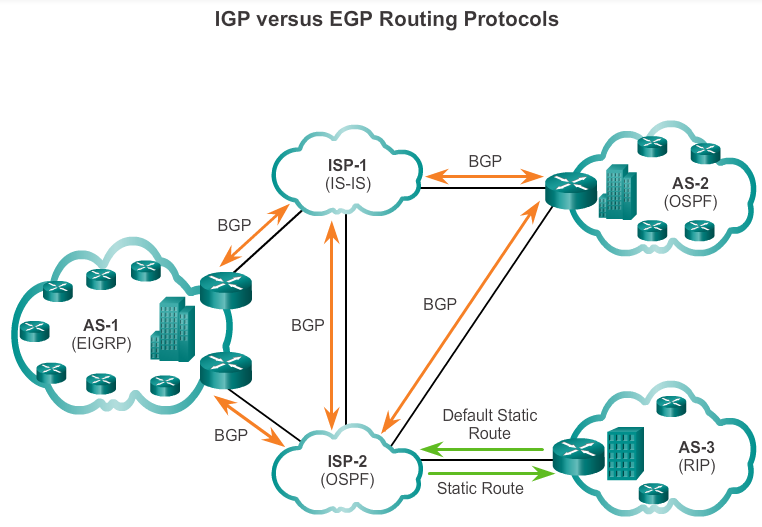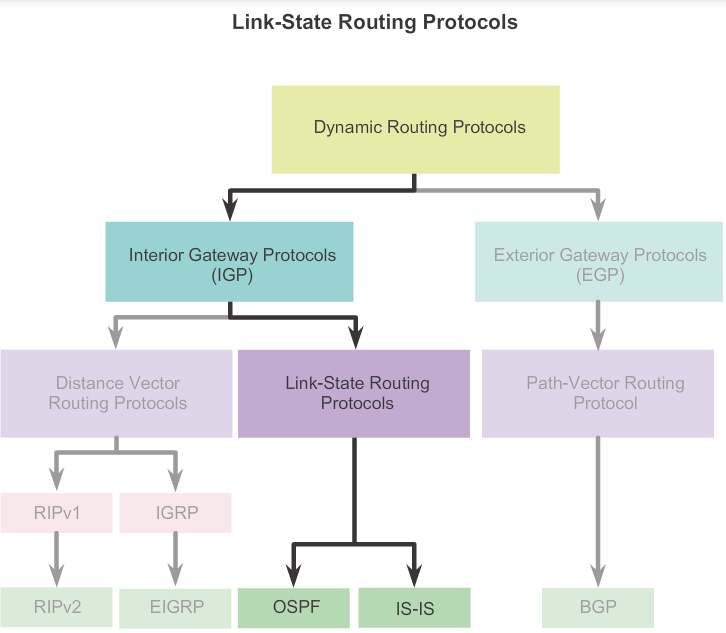Components and terminology of dynamic routing protocols :
- Data structures – Routing protocols typically use tables or databases for its operations. This information is kept in RAM.
- Routing protocol messages – Routing protocols use various types of messages to discover neighboring routers, exchange routing information, and other tasks to learn and maintain accurate information about the network.
- Algorithm – An algorithm is a finite list of steps used to accomplish a task. Routing protocols use algorithms for facilitating routing information and for best path determination.
- Autonomous system (AS) is a collection of routers under a common administration such as a company or an organization. An AS is also known as a routing domain.
To determine which routing protocols are supported by the IOS, use the command :
r1(config)#router ?
bgp Border Gateway Protocol (BGP)
eigrp Enhanced Interior Gateway Routing Protocol (EIGRP)
ospf Open Shortest Path First (OSPF)
rip Routing Information Protocol (RIP)
“D*Ex” in the routing table means EIGRP.
In the IPv6 routing table, the last line will be
L FF00::/8 [0/0]
via Null0, receive
Routing protocol operation
All routing protocols follow the same patterns of operation:
- Cold start: The only information that a router has is from its own saved configuration file stored in NVRAM. If the IP addressing is configured correctly, then the router initially discovers its own directly connected networks.
- Network discovery: If a routing protocol is configured, the next step is for the router to begin exchanging routing updates to learn about any remote routes. At the same time, the router also receives and processes similar updates from other connected routers. Upon receiving an update, the router checks it for new network information. Any networks that are not currently listed in the routing table are added.
- Exchange the routing information: After the routers learning their own directly connected networks and immediate neighbors, the routers exchange the next round of periodic updates until all the routers got the complete and accurate information about the entire network.
- Achieving convergence: Convergence is both collaborative and independent. The routers share information with each other, but independently calculate the impacts of the topology change on their own routes. Convergence properties: speed of propagation of routing information; the calculation of optimal paths.
Types of routing protocol
- Purpose – Interior Gateway Protocol (IGP) or Exterior Gateway Protocol (EGP)
-
- Interior Gateway Protocols (IGP) – Used for routing within an AS. It is also referred to as intra-AS routing. Companies, organizations, and even service providers (ISP) use an IGP on their internal networks. IGPs include RIP, EIGRP, OSPF, and IS-IS.
- Exterior Gateway Protocols (EGP) – Used for routing between AS. It is also referred to as inter-AS routing. Service providers (ISP)and large companies may interconnect using an EGP. The Border Gateway Protocol (BGP) is the only currently-viable EGP and is the official routing protocol used by the Internet, so most engineers simply refer to BGP instead of EGP.

-
- Operation – Distance vector, link-state protocol, or path-vector protocol
- Distance vector: periodic updates the topology state.The router is only aware of the network addresses of its own interfaces and the remote network addresses it can reach through its neighbors.
- Distance – Identifies how far it is to the destination network and is based on a metric such as the hop count, cost, bandwidth, delay, and more.
- Vector – Specifies the direction of the next-hop router or exit interface to reach the destination.
- RIPv1 send update via broadcast addresses(255.255.255.255); RIPv2 and EIGRP, instead, use multicast addresses(224.0.0.9 for RIPv2 and 224.0.0.10 for EIGRP) so that only neighbors that need updates will receive them. EIGRP can also send a unicast message to only the affected neighbor. Additionally, EIGRP will only send an update when needed, instead of periodically.
- Link-state: Create a complete view or topology of the network by gathering information from all of the other routers. Link-state routing protocols do not use periodic updates. After the network has converged, a link-state update is only sent when there is a change in the topology.
- Distance vector: periodic updates the topology state.The router is only aware of the network addresses of its own interfaces and the remote network addresses it can reach through its neighbors.
- Behavior – Classful (legacy) or classless protocol, based on if provide variable-length subnet masks (VLSMs) and classless interdomain routing (CIDR).
So we can classify the protocols like this:
- IPv1 (legacy) – IGP, distance vector, classful protocol
- IGRP (legacy) – IGP, distance vector, classful protocol developed by Cisco (deprecated from 12.2 IOS and later)
- RIPv2 – IGP, distance vector, classless protocol
- EIGRP – IGP, distance vector, classless protocol developed by Cisco
- OSPF – IGP, link-state, classless protocol
- IS-IS – IGP, link-state, classless protocol
- BGP – EGP, path-vector, classless protocol
Metric
A metric is a measurable value that is assigned by the routing protocol to different routes based on the usefulness of that route. In situations where there are multiple paths to the same remote network, the routing metrics are used to determine the overall “cost” of a path from source to destination. Routing protocols determine the best path based on the route with the lowest cost.
Different routing protocols use different metrics. The metric used by one routing protocol is not comparable to the metric used by another routing protocol.
- RIP choose best path based on hop count.
- OSPF choose best path based on bandwidth.
- EIGRP choose best path based on delay, bandwidth, and traffic load, reliability.
The algorithm:
- Mechanism for sending and receiving routing information
- Mechanism for calculating the best paths and installing routes in the routing table
- Mechanism for detecting and reacting to topology changes
Different routing protocols use different algorithms. For example:
- RIP uses the Bellman-Ford algorithm as its routing algorithm. It is based on two algorithms developed in 1958 and 1956 by Richard Bellman and Lester Ford, Jr.
- IGRP and EIGRP use the Diffusing Update Algorithm (DUAL) routing algorithm developed by Dr. J.J. Garcia-Luna-Aceves at SRI International.

